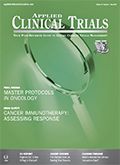What's Behind the Clinical Innovation Gap?
Applied Clinical Trials
Though digital technology has improved the R&D process, when it comes to important clinical benefits and outcomes, modern biotech products have rarely shown the advantages of older generations of drugs.
I’ve been analyzing the discovery times of major medicines or pharma classes that still have important life-saving benefits and have changed the traditional management guidelines of diseases. The breakthrough period started
Bagrat Lalayan

with discovery of antibiotics and continued through the second part of the 20th century. Beta blockers were discovered in 1964, angiotensin-converting enzyme (ACE) inhibitors in 1971, and statins in 1980. Metformin, which is still a leading product in diabetes, was first produced in 1957. Mesalazin, the key medicine to treat inflammatory bowel diseases and Crohn’s, was introduced in 1984. Bisphosphonates were synthetized in the 19th century and commercially implemented in 1960.
What can we say about this?
1. The majority of life-saving drugs that were discovered in the second part of the last century are still at the top of clinical guidelines and considered first-choice medicines.
2. Many breakthrough drugs were discovered before the advent of the biotechnological era and new, postgenomic drugs have not managed to replace them.
3. R&D in the middle of the 20th century was not so much dependent on computerized technologies and was more successful before the period of drafting the human genotype and the introduction of molecular medicine.
The last point is important. Françous Simon and Philip Kotler wrote in Building Global Biobrands (2009) that while biotech output surged, pharmaceutical productivity declined. A decade ago, an annual R&D spend of $15 billion produced 50 new chemical entities; the industry now spends more than $35 billion to produce 30 new compounds.
So why has postgenomic and modern biotechnological research not helped to discover breakthrough medicines similar to those of the past century? Certainly, the progress of R&D is visible in many areas of medicine. For example, the discovery of monoclonal antibodies (MABs) has dramatically improved survival for some cancer types or in the management of rheumatoid arthritis. However, the different and very expensive MABs synthetized in recent years in the fields of cardiology, diabetes, osteoporosis, Crohn’s disease, or psoriasis have not been able to replace the traditional and affordable pharma products discovered 50 or 70 years earlier. Today, we have better understanding of pathophysiology of different diseases on the molecular and genetic level, but modern biotech products rarely show the advantages in terms of important clinical benefits or outcomes, in comparison with the old generation of drugs.
Does this mean that current technologies in R&D do not work? Of course not. The main weakness that I see is that R&D companies and institutions have switched from clinical orientation to more commercial- and technology-driven approaches. As a result, there are fewer people with medical backgrounds involved in preclinical research and more scientists with biotech or biochemical education now leading the molecular discovery phase.
Another issue is that we are stepping back from the classical investigative method, which places human observation, empirical data, scientific intuition, and criticism as the main categories for experimentally proven discovery. We rely too much on artificial intelligence, fight for Nobel Prizes for genomic and molecular discoveries, and place commercial interests ahead of affordable medicines that are able to dramatically prolong lives or prevent serious complications. And there is almost a stagnation in the discovery of new classes of antibiotics, which can have a global threat.
I’m confident successful biotech companies will recruit more medical scientists and specialists for the preclinical and first stages of drugs discovery. However, we should keep in mind that products like metoprolol, metformin, atorvastatin, alendronate, and lisinopril are still high points of pharma R&D, and that they were discovered mainly by practicing doctors and scientists before the implementation of digital technologies.
Bagrat Lalayan, M.D., Ph.D., is founder of Innovapharm and Victoria Consulting LLC (Armenia).
